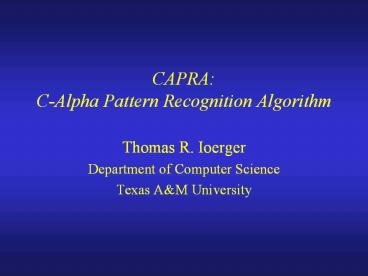CAPRA: C-Alpha Pattern Recognition Algorithm - PowerPoint PPT Presentation
Title:
CAPRA: C-Alpha Pattern Recognition Algorithm
Description:
CAPRA: C-Alpha Pattern Recognition Algorithm Thomas R. Ioerger Department of Computer Science Texas A&M University Overview of CAPRA goal: predict CA chains from ... – PowerPoint PPT presentation
Number of Views:152
Avg rating:3.0/5.0
Title: CAPRA: C-Alpha Pattern Recognition Algorithm
1
CAPRAC-Alpha Pattern Recognition Algorithm
- Thomas R. Ioerger
- Department of Computer Science
- Texas AM University
2
(No Transcript)
3
(No Transcript)
4
(No Transcript)
5
(No Transcript)
6
(No Transcript)
7
(No Transcript)
8
(No Transcript)
9
(No Transcript)
10
(No Transcript)
11
Overview of CAPRA
- goal predict CA chains from density map
- not just tracing - more than Bones
- desire 11 correspondence, 3.8A apart
- based on principles of pattern recognition
- use neural net to estimate which pseudo-atoms in
trace look closest to true C-alphas - use feature extraction to capture 3D patterns in
density for input to neural net - use other heuristics for linking together into
chains, including geometric analysis (s.s.)
12
What can you do with CA chains?
- build-in side-chain and backbone atoms
- TEXTAL, Segment-Match Modeling (Levitt), Holm and
Sander - recognize fold from secondary structure
- identify candidates for molecular replacement
- evaluate map quality (num/len of chains)
- density modification
- create poly-alanine backbone and use it to do
phase recombination
13
Role in Automated Model Building
- Model building is one of the bottlenecks in
high-throughput Structural Genomics - Automation is needed
reflections
PHENIX
(ha/dm/ncs)
map
TEXTAL
model
CA chains
refinement
CAPRA
14
Steps in CAPRA
15
Examples of CAPRA Steps
16
Tracer
17
Neural Network
18
Feature Extraction
- characterize 3D patterns in local density
- must be rotation invariant
- examples
- average density in region
- standard deviation, kurtosis...
- distance to center of mass
- moments of inertia, ratios of moments
- spoke angles
- calculated over spheres of 3A and 4A radius
19
Forward Propagation
Backward Propagation
20
(No Transcript)
21
Selection of Candidate C-alphas
- method
- pick candidates in order of lowest predicted
distance first, - among all pseudo-atoms in trace,
- as long as not closer than 2.5A
- notes
- no 3.8A constraint distance can be as high as 5A
- dont rely on branch points (though often near)
- picked in random order throughout map
- initially covers whole map, including side-chains
and disconnected regions (e.g. noise in solvent)
22
Linking into Chains
- initial connectivity of CA candidates based on
the trace - over-connected graph - branches, cycles...
- start by computing connected components (islands,
or clusters) - two strategies
- for small clusters (lt20 candidates), find
longest internal chain with good atoms - for large clusters (gt20 candidates),
incrementally clip branch points using heuristics
23
Extracting Chains from Small Clusters
- exhaustive depth-first search of all paths
- scoring function
- length
- penalty for inclusion of points with high
predicted distance to true CA by neural net - preference for following secondary structure
(locally straight or helical)
24
Secondary Structure Analysis
- generate all 7-mers (connected fragments of
candidate CAs of length 7) - evaluate straightness
- ratio of sum of link lengths to end-to-end
distance - straightnessgt0.8 gt potential beta-strand
- evaluate helicity
- average absolute deviation of angles and torsions
along 7-mer from ideal values (95º and 50º) - helicitylt20 gt potential alpha-helix
25
Handling Large Clusters
- start by breaking cycles (near bad atoms)
- clip links at branch points till only linear
chains remain - clip the most obvious links first, e.g.
- if other two links are part of sec. struct.
- if clipped branch has bad atom nearby
- if clipped branch is small and other 2 are large
?
?
?
26
Results
27
Analysis of RMS by Sec. Struct. (DSSP)
28
Example of CA-chains for CzrA fit by CAPRA
29
Results for MVK
30
Effect of Resolution
- IF5a
- initial map 2.1A, RMS error 1.23A
- limited map 2.8A, RMS error 0.86A
- PCAa (2Fo-Fc)
- initial map 2.0A, RMS error 1.1A
- limited map 2.8A, RMS error 0.82A
31
Effect of Density Modification
- anecdotal evidence from ICL
- before DM many short, broken chains
- after DM longer chains, reasonable model
- hard to quantify, but the moral is
- the accuracy of CAPRA results depends on
quality of density, and CAPRA might not give
useful results in noisy maps - experiments with blurring maps
- convolution with Gaussian by FFT
32
Future Work
- build poly-alanine
- must determine directionality
- currently done as part of TEXTAL (fits backbone
carbonyls as well as side-chain atoms) - connect ends of chains
- improve robustness to breaks in density
- use partial models to improve phases and hence
make better maps (iteratively) - a new form of density modification?
33
Related Approaches
- Resolve (Terwilliger)
- template convolution search, max. likelihood
- MAID (D. Levitt)
- density correlation search, grow ends
- Critical-point analysis (Glasgow/Fortier)
- ARP/wARP (Perrakis and Lamzin)
- MAIN (D. Turk)
- chiral carbons iterate extend ends, phase
recomb. - X-Powerfit (T. Oldfield, MSI)
34
Availability
- on pompano, add /xray/textal/bin/capra to your
path - run capra ltproteingt where ltproteingt.xplor is
your map in X-PLOR fmt - map should cover at least one whole molecule,
though smallerfaster - takes a minutes to an hour (especially for
feature calculations) - any space group unit cell
- resolution 2.2-3.2A, 2.8A recommended
- remember quality of density must be high, e.g.
post- solvent-flattening, etc.
35
Acknowledgements
- Funding
- National Institutes of Health
- Welch Foundation
- People
- Dr. James C. Sacchettini
- The TEXTAL Group!
- Tod Romo
- Kreshna Gopal
- Reetal Pai































